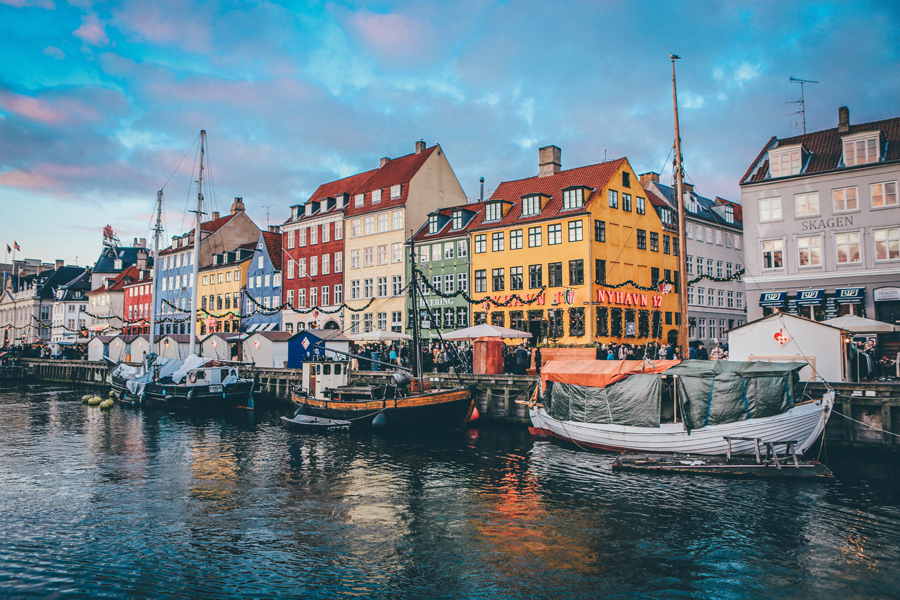Nyhavn is a central is a port district in the Danish capital, Copenhagen, and one of the city’s main attractions.
The picturesque Copenhagen port of Nyhavn is also called the New Harbor. Its length is about a kilometer. A canal was dug here in 1671 to connect the city to the sea. Since then, this place has been a real pride of the Danish capital. The project was developed by the royal engineer Ruzenstein. The city’s name “Copenhagen” translates as “merchant’s harbor”. So after the construction of the port of Nyhavn, merchant ships entered the very center of the city.
The picturesque Copenhagen port of Nyhavn is also called the New Harbor. Its length is about a kilometer. A canal was dug here in 1671 to connect the city to the sea. Since then, this place has been a real pride of the Danish capital. The project was developed by the royal engineer Ruzenstein. The city’s name “Copenhagen” translates as “merchant’s harbor”. So after the construction of the port of Nyhavn, merchant ships entered the very center of the city.
The canal stretches from New Royal Square to the mooring front-port south of the Theater House. Along the canal there are many colorful townhouses from the 17th and 18th centuries, bars, cafes and restaurants. Many historic wooden ships are moored in the canal.
There are many shops, boutiques, restaurants and cafes. Nyhavn has become a favorite destination not only for locals, but also for tourists.
There are many shops, boutiques, restaurants and cafes. Nyhavn has become a favorite destination not only for locals, but also for tourists.
Access : Coordinates: 55.679722, 12.590556 / The water buses stop at the mouth of the canal. All four water buses – 901, 902, 903 and 904 stop at a stop next to the Theater House. / The Kongs Nyuter metro station is located at the end of Nyhavan, at the far end of the square of the same name. The station serves all lines of the Copenhagen Metro.
Contents
Nyhavn is a central is a port district in the Danish capital, Copenhagen, and one of the city’s main attractions.
The picturesque Copenhagen port of Nyhavn is also called the New Harbor. Its length is about a kilometer. A canal was dug here in 1671 to connect the city to the sea. Since then, this place has been a real pride of the Danish capital. The project was developed by the royal engineer Ruzenstein. The city’s name “Copenhagen” translates as “merchant’s harbor”. So after the construction of the port of Nyhavn, merchant ships entered the very center of the city.The canal stretches from New Royal Square to the mooring front-port south of the Theater House. Along the canal there are many colorful townhouses from the 17th and 18th centuries, bars, cafes and restaurants. Many historic wooden ships are moored in the canal.
There are many shops, boutiques, restaurants and cafes. Nyhavn has become a favorite destination not only for locals, but also for tourists.
Highlights :
- The National Museum, the Glyptotek and the Borsen Stock Exchange are nearby. The Museum Port occupies the interior of Nyhavan, between the bridge and Royal Square.
- The Port of Nyhavn in Copenhagen has become a favorite destination for artists and photographers.
- The Nyhavnsbroen bridge between Holbergsgade and Toldbodgade was originally built in 1874-1875 but was replaced by the current drawbridge in 1911-1912. The bridge divides Nyhavn into an inner part, where there are now veteran ships, and an outer part.
- At the beginning of the harbor there is a real anchor, which today reminds of the sailors who died in the Second World War.
- The great writer of fairy tales – Hans Christian Anderson lived in one of the houses on the waterfront.
- Floating lighthouse Gedser Rev XVII is a floating lighthouse built in 1895 in Odense, in use until 1972. The ship was acquired by the National Museum and now serves as a museum ship.
- MA-RI is a ship built to carry contraband in 1920. In 1923, the ship was boarded by the Helsingor customs authorities with contraband on board.
- Mira is a two-masted schooner built in Foborg in 1898. The Mira is considered one of the finest Danish small craft of the time. For many years the ship has transported chalk from Stevns.
- The Boat Theater is a self-propelled lighter-type barge built in Copenhagen in 1898. Since 1972 it has been working as a theater on a ship.
Activities : sightseeing / photo opportunities / canal tour boats / kaffemik – coffee gathering / snapping selfies.
Go next : The 1.1 kilometre Strøget, along with its pedestrianised side streets, is one of the longest pedestrian streets.

